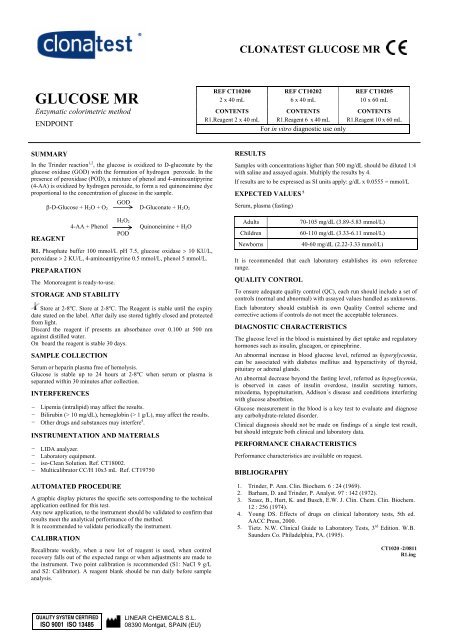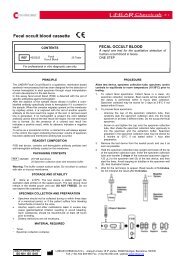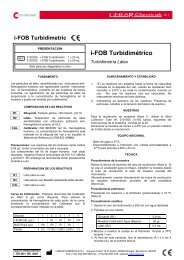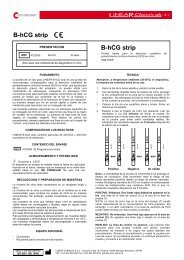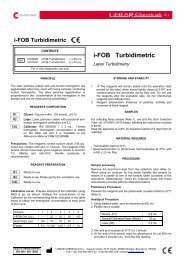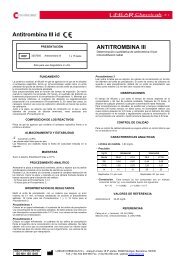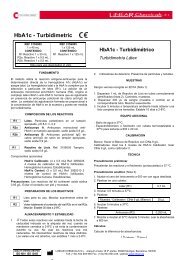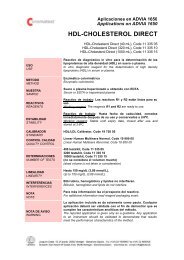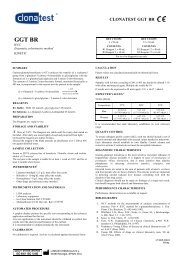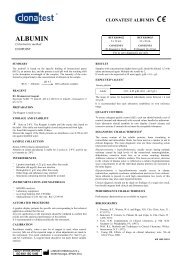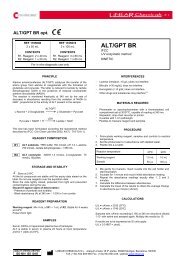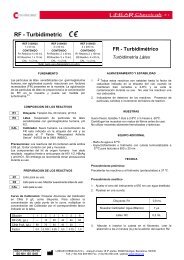GLUCOSE MR - LINEAR CHEMICALS
GLUCOSE MR - LINEAR CHEMICALS
GLUCOSE MR - LINEAR CHEMICALS
Create successful ePaper yourself
Turn your PDF publications into a flip-book with our unique Google optimized e-Paper software.
CLONATEST <strong>GLUCOSE</strong> <strong>MR</strong><br />
<strong>GLUCOSE</strong> <strong>MR</strong><br />
Enzymatic colorimetric method<br />
ENDPOINT<br />
REF CT10200 REF CT10202 REF CT10205<br />
2 x 40 mL 6 x 40 mL 10 x 60 mL<br />
CONTENTS CONTENTS CONTENTS<br />
R1.Reagent 2 x 40 mL R1.Reagent 6 x 40 mL R1.Reagent 10 x 60 mL<br />
For in vitro diagnostic use only<br />
SUMMARY<br />
In the Trinder reaction 1,2 , the glucose is oxidized to D-gluconate by the<br />
glucose oxidase (GOD) with the formation of hydrogen peroxide. In the<br />
presence of peroxidase (POD), a mixture of phenol and 4-aminoantipyrine<br />
(4-AA) is oxidized by hydrogen peroxide, to form a red quinoneimine dye<br />
proportional to the concentration of glucose in the sample.<br />
GOD<br />
β-D-Glucose + H 2 O + O 2 D-Gluconate + H 2 O 2<br />
REAGENT<br />
4-AA + Phenol<br />
Quinoneimine + H 2 O<br />
R1. Phosphate buffer 100 mmol/L pH 7.5, glucose oxidase > 10 KU/L,<br />
peroxidase > 2 KU/L, 4-aminoantipyrine 0.5 mmol/L, phenol 5 mmol/L.<br />
PREPARATION<br />
The Monoreagent is ready-to-use.<br />
STORAGE AND STABILITY<br />
Store at 2-8ºC. Store at 2-8ºC. The Reagent is stable until the expiry<br />
date stated on the label. After daily use stored tightly closed and protected<br />
from light.<br />
Discard the reagent if presents an absorbance over 0.100 at 500 nm<br />
against distilled water.<br />
On board the reagent is stable 30 days.<br />
SAMPLE COLLECTION<br />
Serum or heparin plasma free of hemolysis.<br />
Glucose is stable up to 24 hours at 2-8ºC when serum or plasma is<br />
separated within 30 minutes after collection.<br />
INTERFERENCES<br />
−<br />
−<br />
−<br />
Lipemia (intralipid) may affect the results.<br />
Bilirubin (> 10 mg/dL), hemoglobin (> 1 g/L), may affect the results.<br />
Other drugs and substances may interfere 4 .<br />
INSTRUMENTATION AND MATERIALS<br />
−<br />
−<br />
−<br />
−<br />
H 2 O 2<br />
POD<br />
LIDA analyzer.<br />
Laboratory equipment.<br />
iso-Clean Solution. Ref. CT18002.<br />
Multicalibrator CC/H 10x3 mL Ref. CT19750<br />
RESULTS<br />
Samples with concentrations higher than 500 mg/dL should be diluted 1:4<br />
with saline and assayed again. Multiply the results by 4.<br />
If results are to be expressed as SI units apply: g/dL x 0.0555 = mmol/L<br />
EXPECTED VALUES 5<br />
Serum, plasma (fasting)<br />
Adults<br />
Children<br />
Newborns<br />
70-105 mg/dL (3.89-5.83 mmol/L)<br />
60-110 mg/dL (3.33-6.11 mmol/L)<br />
40-60 mg/dL (2.22-3.33 mmol/L)<br />
It is recommended that each laboratory establishes its own reference<br />
range.<br />
QUALITY CONTROL<br />
To ensure adequate quality control (QC), each run should include a set of<br />
controls (normal and abnormal) with assayed values handled as unknowns.<br />
Each laboratory should establish its own Quality Control scheme and<br />
corrective actions if controls do not meet the acceptable tolerances.<br />
DIAGNOSTIC CHARACTERISTICS<br />
The glucose level in the blood is maintained by diet uptake and regulatory<br />
hormones such as insulin, glucagon, or epinephrine.<br />
An abnormal increase in blood glucose level, referred as hyperglycemia,<br />
can be associated with diabetes mellitus and hyperactivity of thyroid,<br />
pituitary or adrenal glands.<br />
An abnormal decrease beyond the fasting level, referred as hypoglycemia,<br />
is observed in cases of insulin overdose, insulin secreting tumors,<br />
mixedema, hypopituitarism, Addison´s disease and conditions interfering<br />
with glucose absorbtion.<br />
Glucose measurement in the blood is a key test to evaluate and diagnose<br />
any carbohydrate-related disorder.<br />
Clinical diagnosis should not be made on findings of a single test result,<br />
but should integrate both clinical and laboratory data.<br />
PERFORMANCE CHARACTERISTICS<br />
Performance characteristics are available on request.<br />
BIBLIOGRAPHY<br />
AUTOMATED PROCEDURE<br />
A graphic display pictures the specific sets corresponding to the technical<br />
application outlined for this test.<br />
Any new application, to the instrument should be validated to confirm that<br />
results meet the analytical performance of the method.<br />
It is recommended to validate periodically the instrument.<br />
CALIBRATION<br />
Recalibrate weekly, when a new lot of reagent is used, when control<br />
recovery falls out of the expected range or when adjustments are made to<br />
the instrument. Two point calibration is recommended (S1: NaCl 9 g/L<br />
and S2: Calibrator). A reagent blank should be run daily before sample<br />
analysis.<br />
1.<br />
2.<br />
3.<br />
4.<br />
5.<br />
Trinder, P. Ann. Clin. Biochem. 6 : 24 (1969).<br />
Barham, D. and Trinder, P. Analyst. 97 : 142 (1972).<br />
Szasz, B., Hurt, K. and Busch, E.W. J. Clin. Chem. Clin. Biochem.<br />
12 : 256 (1974).<br />
Young DS. Effects of drugs on clinical laboratory tests, 5th ed.<br />
AACC Press, 2000.<br />
Tietz. N.W. Clinical Guide to Laboratory Tests, 3 rd Edition. W.B.<br />
Saunders Co. Philadelphia, PA. (1995).<br />
CT1020 -2/0811<br />
R1.ing<br />
QUALITY SYSTEM CERTIFIED<br />
ISO 9001 ISO 13485<br />
<strong>LINEAR</strong> <strong>CHEMICALS</strong> S.L.<br />
08390 Montgat, SPAIN (EU)
CLONATEST <strong>GLUCOSE</strong> <strong>MR</strong><br />
GLUCOSA <strong>MR</strong><br />
Método enzimático colorimétrico<br />
PUNTO FINAL<br />
REF CT10200 REF CT10202 REF CT10205<br />
2 x 40 mL 6 x 40 mL 10 x 60 mL<br />
CONTENIDO CONTENIDO CONTENIDO<br />
R1.Reactivo 2 x 40 mL R1.Reactivo 6 x 40 mL R1.Reactivo 10 x 60 mL<br />
Sólo para uso diagnóstico in vitro<br />
FUNDAMENTO<br />
En la reacción de Trinder 1,2 , la glucosa es oxidada a D-gluconato por la<br />
glucosa oxidasa (GOD), con formación de peróxido de hidrógeno. En<br />
presencia de peroxidasa (POD), el fenol y la 4-aminoantipirina (4-AA) se<br />
condensan por acción del peróxido de hidrógeno, formando una<br />
quinonaimina roja proporcional a la concentración de glucosa en la<br />
muestra.<br />
GOD<br />
β-D-Glucosa + H 2 O + O 2 D-Gluconato + H 2 O 2<br />
REACTIVO<br />
4-AA + Fenol<br />
Quinonaimina + H 2 O<br />
R1. Tampón fosfatos 100 mmol/L pH 7,5, glucosa oxidasa > 10 KU/L,<br />
peroxidasa > 2 KU/L, 4-aminoantipirina 0,5 mmol/L, fenol 5 mmol/L.<br />
PREPARACION<br />
El Monoreactivo está listo para su uso.<br />
ALMACENAMIENTO Y ESTABILIDAD<br />
Conservar a 2-8ºC. El Reactivo es estable hasta la fecha de caducidad<br />
indicada en la etiqueta.<br />
Después de su uso diario, mantener bien cerrado y protegido de la luz.<br />
Desechar el reactivo cuando presente una absorbancia superior a 0,100 a<br />
500 nm frente agua destilada. En el analizador es estable 30 días.<br />
MUESTRAS<br />
Suero o plasma heparinizado libre de hemólisis.<br />
La glucosa es estable unas 24 horas a 2-8ºC, cuando el suero o el plasma<br />
se separa dentro de los 30 minutos posteriores a la extracción.<br />
INTERFERENCIAS<br />
−<br />
−<br />
−<br />
Lipemia (intralipid ) puede afectar los resultados.<br />
Bilirrubina (> 10 mg/dL), hemoglobina (> 1 g/L) interfieren.<br />
Otros medicamentos y sustancias pueden interferir 4 .<br />
EQUIPO ADICIONAL<br />
−<br />
−<br />
−<br />
−<br />
Analizador LIDA.<br />
Material de laboratorio.<br />
iso-Clean Solution. Ref. CT18002.<br />
Multicalibrator CC/H 10x3 mL Ref. CT19750<br />
TECNICA AUTOMATICA<br />
Una representación grafica visualiza los ajustes específicos<br />
correspondientes a la aplicación técnica diseñada para este ensayo.<br />
Cualquier aplicación nueva al instrumento deberá validarse para<br />
confirmar que los resultados cumplen las características del método.<br />
Se recomienda validar periódicamente el instrumento.<br />
CALIBRACION<br />
H 2 O 2<br />
POD<br />
Recalibrar semanalmente, al cambiar el lote de reactivos, cuando los<br />
valores del control estén fuera del rango de aceptación o cuando se<br />
realicen ajustes en el instrumento. Se recomienda la Calibración de dos<br />
puntos (M1: ClNa 9 g/L y M2: Calibrador). Realizar un blanco del<br />
reactivo cada día de trabajo antes de analizar las muestras.<br />
CALCULOS<br />
Muestras con concentraciones superiores a 500 mg/dL deben diluirse 1:4<br />
con solución salina y repetir el ensayo. Multiplicar los resultados por 4.<br />
Para expresar los resultados en unidades SI : mg/dL x 0,0555 = mmol/L<br />
VALORES DE REFERENCIA 5<br />
Suero, plasma (en ayunas)<br />
Adultos<br />
Niños<br />
Neonatos<br />
70-105 mg/dL (3,89-5,83 mmol/L)<br />
60-110 mg/dL (3,33-6,11 mmol/L)<br />
40-60 mg/dL (2,22-3,33 mmol/L)<br />
Se recomienda que cada laboratorio establezca su propio rango de<br />
referencia.<br />
CONTROL DE CALIDAD<br />
Para un control de calidad (CC) adecuado, se incluirán en cada serie<br />
controles valorados (normal y abnormal) que se tratarán como muestras<br />
problema.<br />
Cada laboratorio debe establecer su propio Control de Calidad y sus<br />
medidas correctoras cuando los controles no cumplan con las tolerancias<br />
exigidas.<br />
SIGNIFICADO CLINICO<br />
Un aumento anormal en la tasa de glucosa sanguínea, conocida como<br />
hiperglucemia, puede estar asociado con la diabetes mellitus y con la<br />
hiperactividad de las glándulas adrenales, tiroides o pituitaria.<br />
La hipoglucemia o disminución anormal por debajo de la tasa hallada en<br />
ayunas, se observa en casos de sobredosis de insulina, tumores secretores<br />
de insulina, hipopituitarismo, enfermedad de Addison, mixedema y<br />
condiciones que interfieren con su absorción.<br />
La determinación de glucosa en sangre, es una prueba clave para evaluar y<br />
diagnosticar desórdenes relacionados con el metabolismo de los<br />
carbohidratos.<br />
El diagnóstico clínico no debe realizarse únicamente con los resultados de<br />
un único ensayo, sino que debe considerarse al mismo tiempo los datos<br />
clínicos del paciente.<br />
CARACTERISTICAS ANALITICAS<br />
Las características analíticas están disponibles bajo solicitud.<br />
REFERENCIAS<br />
1.<br />
2.<br />
3.<br />
4.<br />
5.<br />
Trinder, P. Ann. Clin. Biochem. 6 : 24 (1969).<br />
Barham, D. y Trinder, P. Analyst. 97 : 142 (1972).<br />
Szasz, B., Hurt, K. y Busch, E.W. J. Clin. Chem. Clin. Biochem. 12<br />
: 256 (1974).<br />
Young DS. Effects of drugs on clinical laboratory tests, 5th ed.<br />
AACC Press, 2000.<br />
Tietz. N.W. Clinical Guide to Laboratory Tests, 3 rd Edition. W.B.<br />
Saunders Co. Philadelphia, PA. (1995).<br />
QUALITY SYSTEM CERTIFIED<br />
ISO 9001 ISO 13485<br />
<strong>LINEAR</strong> <strong>CHEMICALS</strong> S.L.<br />
08390 Montgat, SPAIN (EU)


